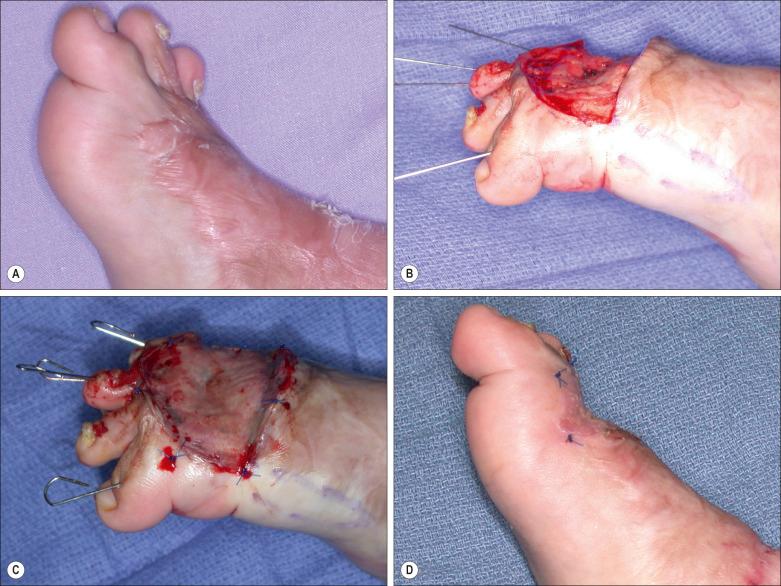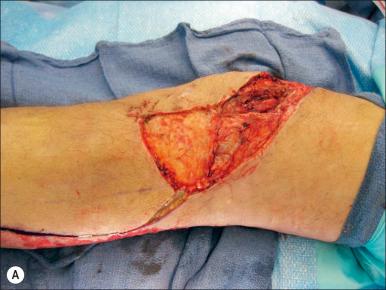Physical Address
304 North Cardinal St.
Dorchester Center, MA 02124
Acute care of a burned lower extremity prioritizes circulation and coverage. These goals are achieved through escharotomies and fasciotomies as necessary and excision and coverage of the burn wounds. Reconstruction of lower-extremity burn sequelae, however, requires a more complex and detailed definition of defects, deformities, and functional goals. Assessment of a lower limb for secondary postburn reconstruction is therefore directed toward a useful outcome.
Sensation is an important element in lower-extremity salvage potential. A desensate foot can be a source of chronic wounds and may be a less functional outcome than a below-knee prosthesis. Treatable sites of sensory nerve compression are increasingly recognized in burned lower extremities, and nerve decompression at the tarsal tunnel (for plantar sensation) and the popliteal fossa (for dorsal sensation) can be initially considered to restore foot sensation.
Muscle function must be sufficient to provide useful active motion at the ankle, knee, and hip. If direct muscle damage is incompatible with function, limb salvage may be abandoned. Some muscle deficits, such as peroneal nerve palsy with foot drop, may be associated with nerve compression, and decompression may be an effective reconstruction to restore muscle function.
Satisfactory lower-extremity salvage potential requires functional skeletal components. Associated fractures must be stably healed. Major joints must have sufficient cartilage surfaces and capsule integrity to contribute to limb function.
When evaluating a lower-extremity soft tissue burn complication, the surgeon should consider whether the problem is a deformity or a defect.
A deformity implies a distortion of parts correctible by rearrangements of local tissue. For example, a single vertical scar band across a popliteal fossa, causing a flexion contracture of the knee, may be incised and lengthened by local Z-plasties that transpose adjacent supple tissue into the scar site and permit knee extension. A defect is an absence of parts and requires replacement by distant tissue. Dorsal toe contractures, when released, may be secondary to soft tissue deficiency which, when revealed by contracture release, will require skin grafts to cover the defect ( Fig. 56.1 ). Full-thickness soft tissue loss around a knee joint may require a local muscle flap (e.g., a gastrocnemius belly) or a microsurgical flap for adequate treatment of the defect ( Fig. 56.2 ). Clear definition of the problem should result in an appropriate selection of a reconstruction strategy.


Finally the status of the second lower-extremity provides a context for assessment of the burned lower extremity. A patient with one intact lower extremity may be less interested in complex reconstructive salvage of a functionally impaired extremity. Elective amputation with prosthetic may be a less complicated path to ambulation supported by the uninjured extremity. Two injured lower extremities, however, may make reconstruction a higher priority in either or both since loss of both lower extremities is a substantially greater disability than single lower-extremity loss.
Assessment of burn injuries to a lower extremity can lead to the conclusion that there is insufficient salvage potential to justify attempts at reconstruction. Lack of sensation, extensive muscle or joint damage, and a functioning second lower extremity may add up to a decision to amputate the impaired portion of a lower extremity.
Dislocated, dorsally contracted toes can be removed with simple amputations at the metatarsophalangeal joints. More extensive damage to the forefoot can be treated with amputations at the tarso-metatarsal level or through the ankle joint (Lisfranc and Symes procedures, respectively). Such amputations require sufficient sensation and circulation to obtain a stable result.
Unreconstructable injury involving the foot and ankle can proceed to below-the-knee amputation. The priorities of that procedure include stable coverage of the tibia and fibula as well as preservation of sufficient skeletal length to support a prosthesis. The amputation closure is best achieved with tissue from the posterior calf. A refinement of amputation closure consists of using the proximal gastrocnemius muscle and its overlying skin to create a durable, myocutaneous pad. This technique can be further modified to use gastrocnemius muscle covered with skin grafts from initial burn care ( Fig. 56.3 ).

Severe damage extending proximal to the knee may lead to above-knee amputation. In this procedure, maximum secure length is useful. Anterior and posterior thigh muscles are mobilized and stabilized to each other to form the basis of closure of the overlying skin. Here also muscle covered with skin grafts can be satisfactory for stable stump closure.
Hip disarticulation can be life-saving in burn wounds of the groin and perineum exposing major vessels. In late reconstruction of contractures of the hip, a hip disarticulation can replace a nonfunctional lower extremity with a stable wound that can support a prosthesis.
Become a Clinical Tree membership for Full access and enjoy Unlimited articles
If you are a member. Log in here